There was a time when Sam Jinks became a little depressed. He had been making too many dead bodies and monsters, he says, his accent a soft burr as we speak. The Australian artist had been working on film sets, and the horror films, in particular, were getting to him.
These days, the incredibly lifelike bodies he creates are of a gentler, yet far more powerful sort. “There’s a language in film that’s a lot easier than art,” he explains. “Art is hard, because you’re trying to change someone’s perception of the world. You’re trying to move someone in some way.”
Over the millenniums since we first scratched animals and shapes on caves, makers have wrestled with that idea of moving people, trying to engender feeling, even as they have also tried to represent the world before their eyes. Of course the invention of the camera meant you didn’t have to catch the actual image of a person, place or thing; though artists have continued to return to figures and landscapes again and again.
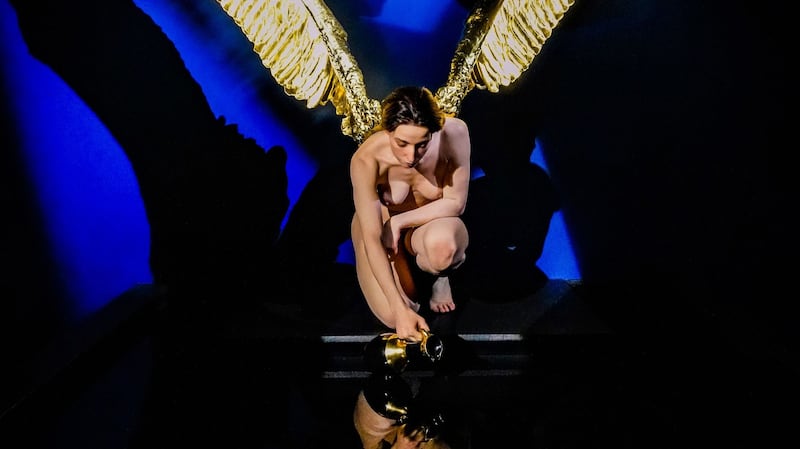
Jinks goes one better. His sculptures – fibreglass and silicone figures tufted with real hair, and pigmented in lifelike skin tones – are, for want of a better term, “hyperreal”.
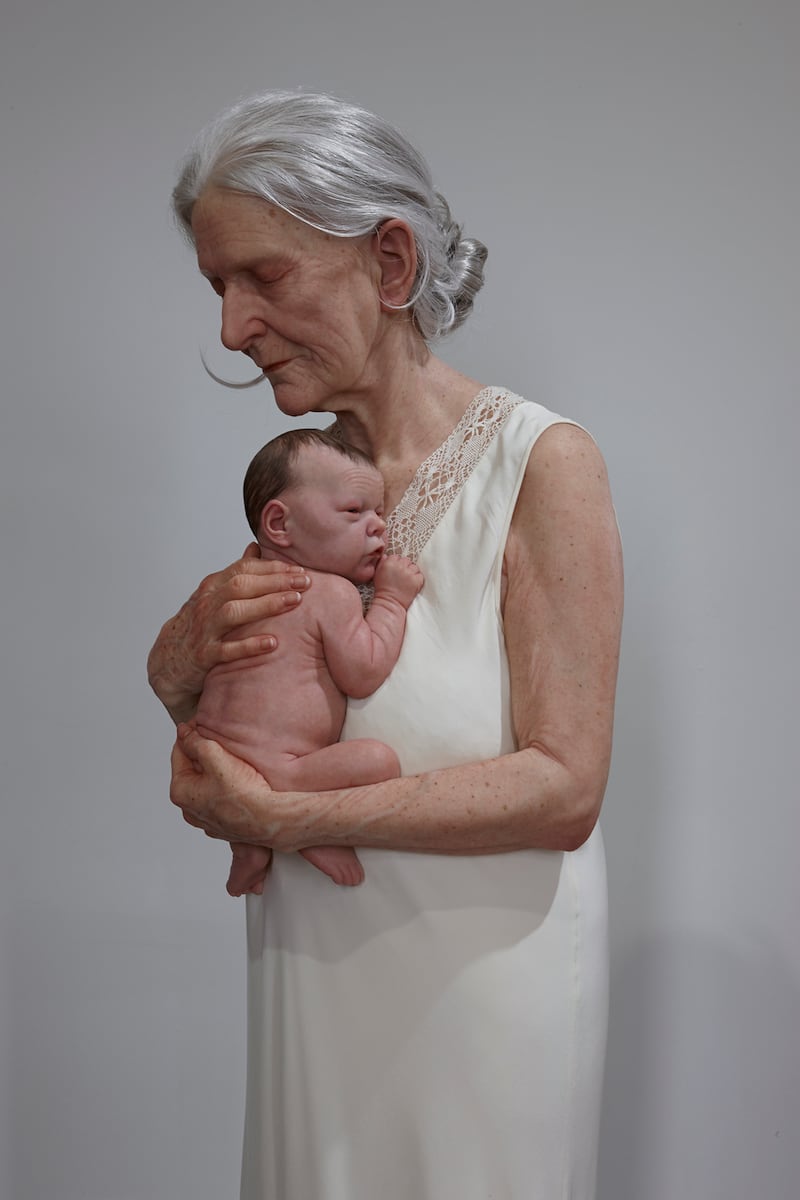
Jinks himself is uncomfortable with the word, with its suggestions of Disney-esque excess. “I have dipped in and out of it,” he says. “It has been difficult for anyone who works in a realistic medium. If you look at any of it, it’s all a bit distorted. When someone says ‘hyperreal’, I think of Madame Tussaud’s, and of prosthetic legs.” Instead, his sculptures: whether they draw on myth, religious art, or the simple grit, joys and sorrows of humanity; use the space between the incredibly real and the not quite perfect, to make a space for feeling and imagination to come through. In practice, this means his figures are either slightly under life size, or else made massive. The point is to see enough to feel, without looking for a reflection or a projection of yourself.
Equally, Jinks abandoned a process that involved 3D scanning and printing of his models, for the more intuitive method of modelling in clay, which he then casts and coats in silicone. “I really tried,” he says of his forays into 3D technology. “But in the act of trying, I found what I wound up with was something dead. That’s a harsh way of putting it, but it’s not as interesting as when you’re sculpting by hand. With a 3D printer, you wind up with a fight. Wanting to get it as close to reality as possible, you lose the energy.” Instead, the energy comes from the idea as well as through its execution. “A lot of unconscious decisions are made, and they are part of who you are. The skin, the texture of bones over muscle, they’re all interpretive, that’s what makes the work.”
We're talking ahead of Jinks's Galway Arts Festival exhibition, which will open at the festival's latest galleries in the former Post Office on William Street. The programmers at Galway are adept at picking festival exhibitions: from David Mach's Rock'n'Roll, to Ana Maria Pacheco's Dark Night of the Soul, to John Gerrard's Cuban School; they understand how to commission shows that have the power and punch to grab attention from a mixed festival audience, and then reward with thoughtful content. Jinks has been following the building progress via Skype, as he imagines the dramatics of the exhibition. "I've always wanted to go to Ireland," he says, looking forward to arriving for the installation.
Virtual reality
It’s a strange thing, speaking about experiences of reality, virtual reality and hyperreality, while imagining the person on the end of the line, on the other side of the world. In photographs Jinks has dark, intense eyes, dark hair, and a salt and pepper beard. His maternal grandparents were Irish, and while he had no formal art training, family life was creative. His mother worked as a nurse and a painter, and his father was both a carpenter and a school teacher. He taught maths and physics, and from what Jinks says, they were the perfect parents for a creative child hindered by an unbrilliance in the more formal tasks of maths and writing. “My father always said mathematics comes in a different way to different people, and he was right, I can triangulate in space. But in school, I struggled with writing.”
While this struggle may have kept him from applying to art school (he has said elsewhere that he simply didn’t have the skills to cope with the inevitable writing assignments), it hasn’t hampered his thought process. He is warm, thoughtful and engaging in conversation, and while writing might come hard, he has a gift with words. Art is good for people like him. It is vital in fact, being a visual outlet for thinking and feeling. It also helps that his parents were wise enough to let him explore his talents in his own way – which included drawing from the age of three, and experimenting with making from his teens. “I had been making with silicone since I was fourteen in the 1980s,” he recalls. “There was no instruction manual for it, I was using bathroom sealant. That was all that was available.”
He found work as a commercial artist, on films, and also a stint prototyping toys. “I felt uncomfortable, there was no purpose to them, beyond amusing someone for a very brief moment in time.” He goes on to talk about the pointlessness of making more stuff, of filling up the world with stuff. An early sculpture, which will feature in the Galway exhibition, is The Hanging Man, an emaciated figure, suspended from two metal supports. “I made that when I was kind of confused by art generally,” he says, as if in forgiveness of the piece, although it still clearly has a resonance.
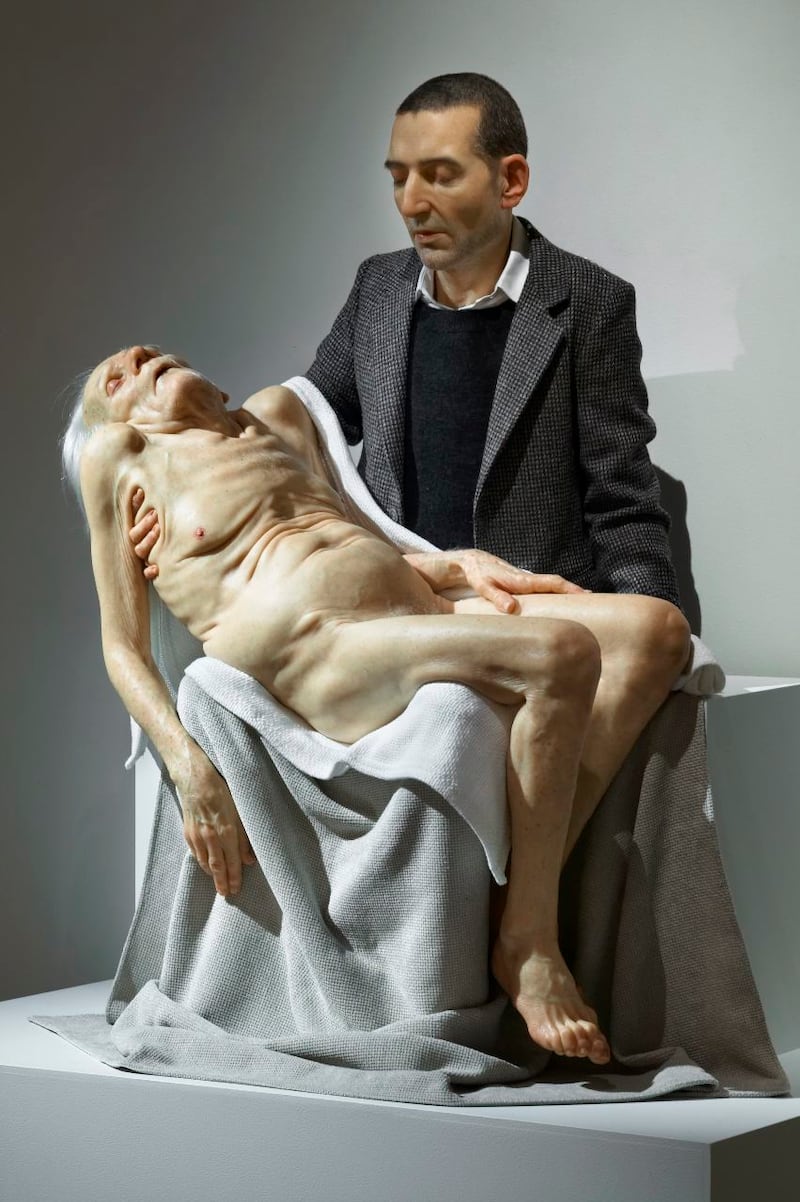
Today, his mother makes the clothes for a lot of his sculptures, and his own son has posed for some pieces. Assistants will come in to help with the time-consuming hair work, although he also finds that part of the process quite meditative. Jinks spent a number of years as a studio assistant for Patricia Piccinini, whose own exhibition at Galway in 2015 took similar materials and bent them to satisfyingly strange ends. Then there is fellow Australian Ron Mueck, now based in the UK, who leapt to prominence with his half-scale lifelike sculpture Dead Dad at the Saatchi Sensation exhibition in 1997.
It is unfair, however, to fit Jinks into a continuum with these artists, simply because he uses the same media. Instead, you have to look at what an artist is trying to say, rather than the materials through which they doing the telling. “The medium is inherently problematic,” agrees Jinks. “If you’re pursuing a realism on any level, when do you stop? You’re pursuing a level that’s basically unattainable. With the Pieta, I had a vision in my mind of something so beautiful and perfect. So when you’re working on it, how do you get there?”
Perfect metaphor
In this, he has actually come up with the perfect metaphor for all art, and for all creative pursuits that attempt to match what is inside the mind with an external articulation of it. The best we can hope for is an approximation. I’m reminded of the line from Yeats, in The Fisherman, where the poet is hoping, before he is old, to have written “one Poem maybe as cold and passionate as the dawn.” Perhaps, I say to Jinks, you never do – get there, I mean.
“With my work, it’s a symbol,” he says. “It becomes a precious object that goes beyond the object – when you look at a crucifix, there’s a lot of loaded power, it’s a loaded image. It works on multiple levels. It’s not just a strange object of someone nailed to a cross. It’s a source of comfort and eternal life if you’re a believer.” In earlier interviews, Jinks has said he’s not a believer himself. Something makes me wonder if that has changed.
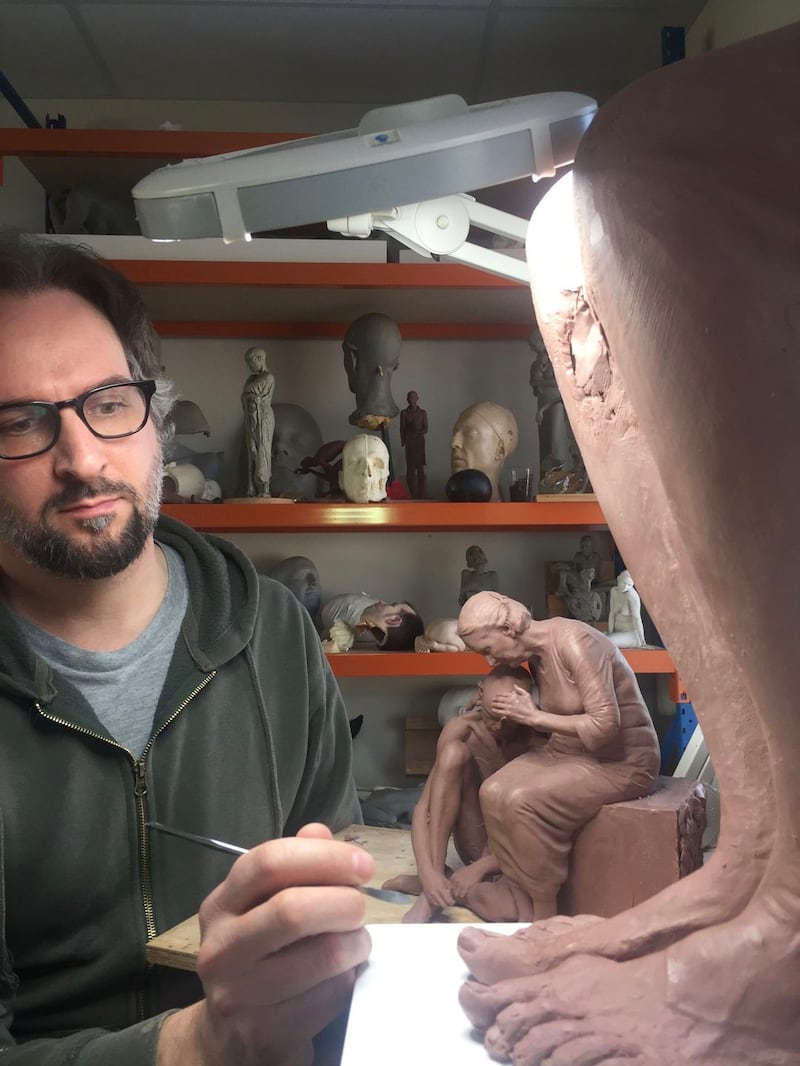
In Galway, myth, religion and humanity will mingle. You will be able to weave your way through works including a pair of crouching babies, and an embryo, which Jinks had included to show the “nothingness” from which we all come. I mention that in Ireland the image has a particular resonance, having been plastered over billboards during the recent repeal referendum, with strong arguments as to that “nothingness”. But again, that’s the thing about good art, it’s open and yet robust enough to absorb readings across place and time, while remaining essentially itself.
In Deposition, an older woman comforts a younger man, who sits at her feet. “The reality of human beings is extraordinary,” says Jinks. “We’re aware of our own mortality. That is empowering, but also incredibly sad. So many decisions we make are affected by the knowledge that we’ll pass, that we are transitory. My work is a reaction, of me trying to make that ok. But,” he adds, more cheerily. “It’s not all about death.”

One of the more enigmatic figures is fully shrouded, like one of those sculptures they used to do centuries ago, to show how good they were making marble look like cloth, with nothing more than a chisel and some sandpaper. “It’s called Devil Halfway,” says Jinks. “My grandmother always said that: don’t meet the devil halfway; I think it’s an Irish term. Its been a common theme in my life. Don’t project too far in to the future. Don’t presume to know what’s going to happen next.”
Still, we continue to try: the culmination of the Galway show, The Messenger, is a winged female figure, crouching at a reflecting pool, ready to exchange information between this world and the next, now and the future, or between our own feelings and intellect, perhaps.
“Life is strange,” continues Jinks. “The older I get, the stranger and more curious it becomes. I’m certainly not a Christian, but there is some strange something. It’s almost unspeakable, you can’t put it into words. I’m kind of grappling with that at the moment. The dream,” he continues, “is one day to make a work that has the power, without the association with religion. A work that has the power a religious piece has, for everybody. We’re sorely in need of these symbols. The ones that make everything ok.”
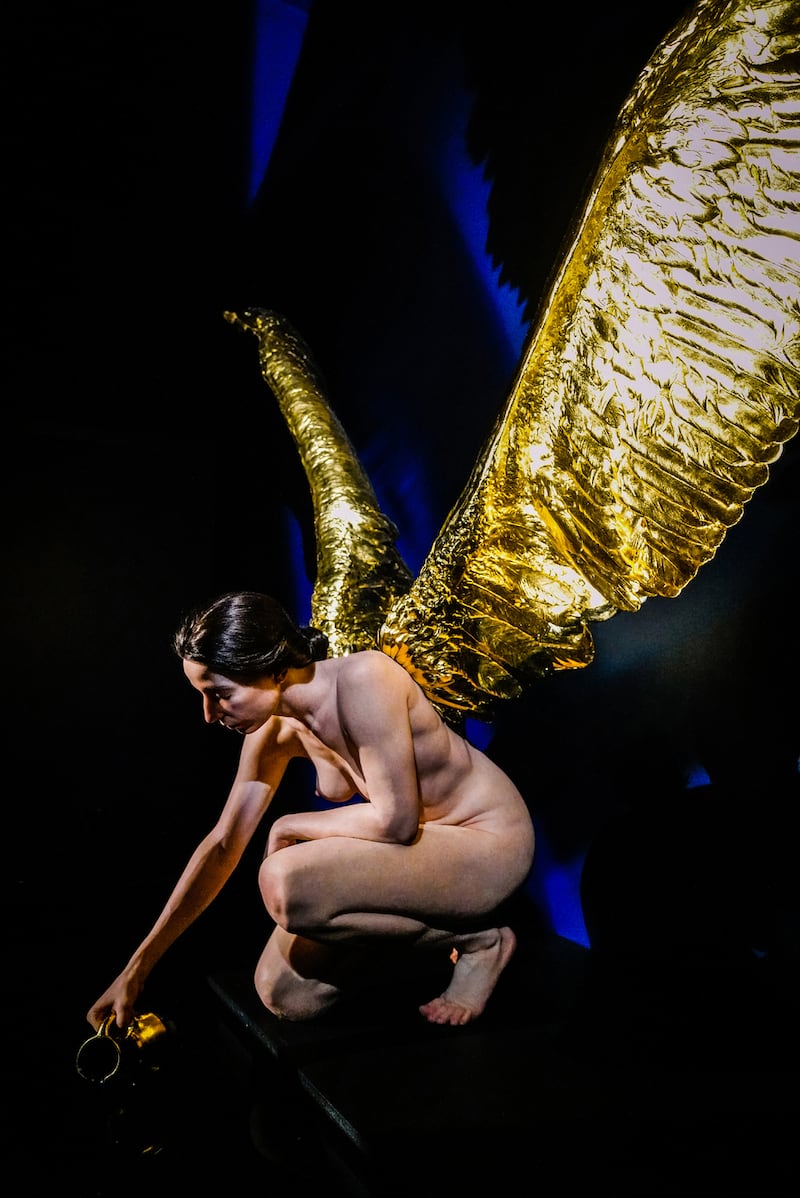
More art at the Galway Festival
6SKIN: take two brilliant artists – Aideen Barry and Alice Maher, add choreography from Junk Ensemble and a score by David Stalling, and you might start to imagine this film, but I bet it beats expectations. O'Donoghue Theatre, NUI Galway
Reforming: Diana Copperwhite is making international waves with her dreamy, yet highly charged, colourful painting. Here she teams up with emerging artist Ciara Barker for an installation at 126 on St Bridget's Place
Making Space: It's 50 years since the first person set foot on the moon. Following a collaboration with NUI Galway's Centre of Astronomy, Chloe Brennan, Louise Manifold, Jane Cassidy and Treasa O'Brien get starry eyed on lunar themes. Galway Arts Centre
Gathered from the Earth: Back down to earth, Joe Hogan makes celestially brilliant baskets. Some are functional, some are sculptural. Most are both. Kenny Gallery
Placing Home: Sarah Hickson's Sounds Unseen at last year's Festival explored life at the Calais Jungle. This year, she turns her eye to those living in direct provision in Galway. O'Donoghue Theatre, NUI Galway
In the Flesh is at the Galway International Arts Festival from July 15th to 28th. giaf.ie




















